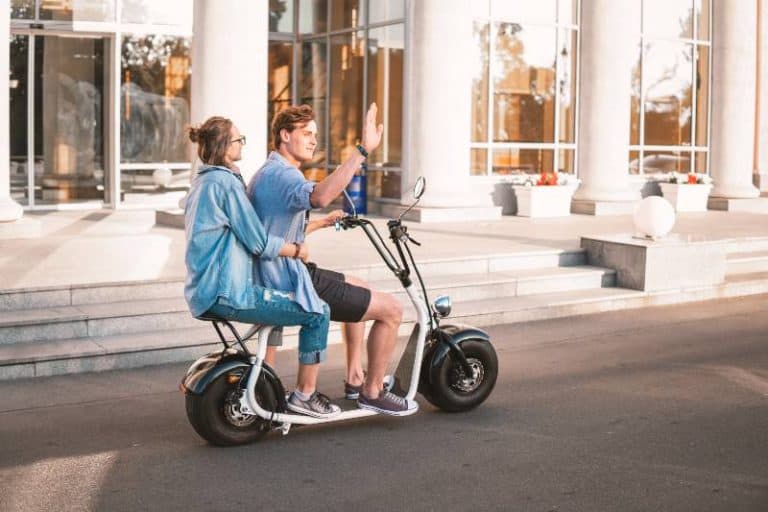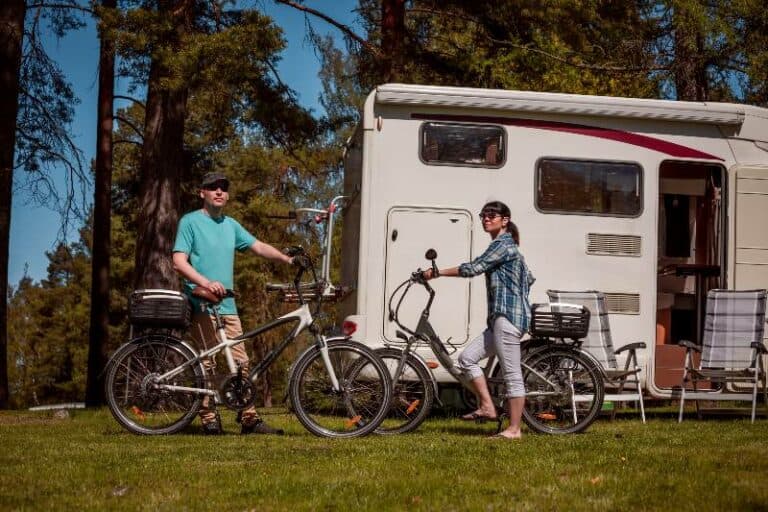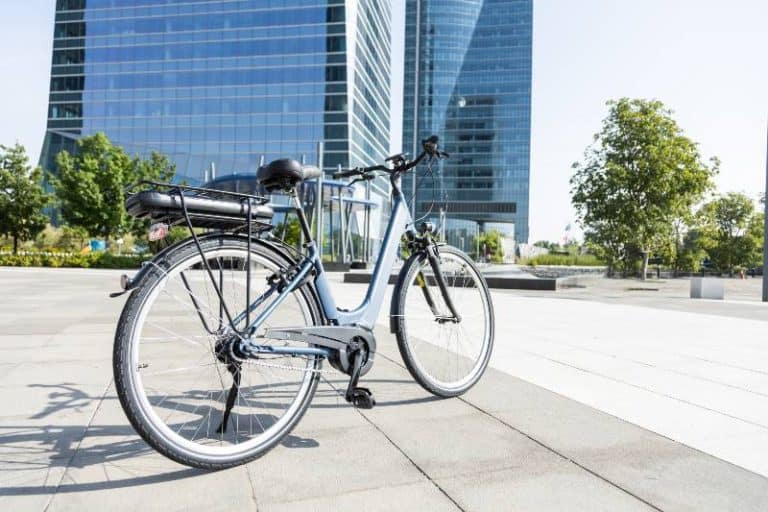E-Bikes Take the Mountain: A Guide to Electric Mountain Biking
Electric mountain biking, commonly known as EMTB, is becoming increasingly popular as experts promote it as an exciting and exhilarating outdoor activity. E-bikes are a specialized type of bicycle that is equipped with an electric motor to increase its speed and power, allowing riders to conquer complex terrains more easily. The major advantage of using mountain e-bikes compared to regular bikes is that they provide assistance with less physical effort.
Because of their distinctive capabilities and practical uses, this guide has been created to help those interested in embarking on an electric mountain biking adventure become familiar with the basics of the sport. It provides information regarding which Mountain Ebikes are best suited for different terrain types, along with maintenance and storage tips as well as other important advice related to optimum performance and safety.
An electric mountain bike can help you if you plan to traverse steep hills, mountain trails, or treacherous roads. Depending on the terrain and area you plan to ride in, the type of e-bike you purchase can significantly impact your experience.
Key Takeaways
- Electric mountain biking is an exciting and exhilarating outdoor activity perfect for those looking to conquer complex terrains.
- Investing in a quality e-bike that meets the demands of the terrain is essential for optimum performance.
- Regular maintenance, proper storage, and safety equipment are important considerations when embarking on an electric mountain bike.
Types of Mountain E-Bikes
Hardtail Mountain E-Bikes
A hardtail eBike offers an unbeatable combination of comfort and versatility that is perfect for experienced and entry-level riders alike. With increased speed, handling, and a lightweight feel, you will enjoy smooth rides, whatever the terrain. A hardtail bike range offers excellent value without compromising on quality or comfort, while their easy maintenance makes them great as both commuter bikes and trail bikes – adding the fun back into cycling. So if you’re looking for a mountain e-Bikes that combines style, function, and comfort perfectly, then look no further than a hardtail range!
Full Suspension Mountain E-Bikes
If you are a mountain biker who places an emphasis on comfort even when traversing rough or challenging terrain or plan to go on alpine tours, a full-suspension e-MTB is the ideal choice. These bikes provide more traction than their hardtail counterparts and offer improved balance due to their low center of gravity. Furthermore, the greater travel provided by full-suspension e-mountain bikes allows for ample reserves when riding aggressively; perfect for those looking to explore their limits and take bigger jumps in the Alps or at bike parks.
Fat Tire Mountain E-Bikes
The sizes 20, 24, and 26 inches are the most typical for bicycle tires, but the defining characteristic of fat tires is a width of four inches or more.
In contrast to traditional tires, fat tires can be ridden at a range of pressures, which are expressed in pounds per square inch (psi). The majority of fat tires have an inflation range of 5 to 30 psi, which enables the tire pressure to be adjusted according to the terrain at any given time.
On a paved road, a tire with a pressure of 30 psi will function the best. However, if you are driving on a surface with softer characteristics, such as wet sand or snow, lowering the psi will increase the surface area contact and give greater float.
Fat tire electric bikes are available in a number of different frame designs, some of which include step-through frames, folding frames, and fat tire electric mountain bikes as their names suggest. Once more, the breadth of the tire is the determining factor.
The increased weight of the bicycle is often caused by the use of larger rims in conjunction with wider tires. This can be decreased by cutting out portions of the rim, which in turn reduces the mass of the rim. It might not seem like much, but when you factor in the weight of the motor, the battery, and the controller, four pounds is actually quite a bit.
Therefore, fat tire electric bicycles are typically heavier than other types of e-bikes and unquestionably heavier than regular bicycles. This will not be much of a problem while you are riding, but if you need to load your bike onto a rack or carry it up and down stairs, it may be difficult for you to do so.
Key Features to Consider when Buying a Mountain E-Bike
Motor System
When shopping for a mountain e-bike, one of the most important elements to consider is the motor system. It’s essential for the motor system to provide sufficient torque and power so you can tackle challenging trails comfortably and safely. Be sure to check reviews and compare specs across different models before purchasing, as this will give you an indication of how well each bike can handle steep climbs and rough terrain.
Battery Capacity
When looking to purchase a mountain e-bike, it is essential to consider the battery capacity. The types of batteries available vary and choosing the best one for your biking needs requires taking into account the terrain on which you will be riding, as well as the distances you are likely to travel. Certain lithium-ion batteries provide more distance but come with a higher cost, while other less expensive alternatives are better suited for shorter trips. An informed decision about the battery capacity should factor into anyone’s decision before investing in an e-bike.
Frame Material
Without a doubt, selecting the right frame material should be one of your highest priorities when it comes to buying an electric bike. It will significantly influence factors like stability, weight support, shock absorption, and other performance characteristics.
When looking to purchase a mountain e-bike, it is important to consider the frame material. Different materials provide different levels of durability and are lightweight. Aluminum alloy is often used for frames due to its price point and strength; however, a carbon frame offers much lighter bike frames but may be more expensive.
Ultimately, the decision should come down to what will best fit one’s individual needs and budget. Additionally, factors such as the overall weight of the e mountain bike—including equipment—and the type of terrain where it will be used should be taken into account before finalizing a purchase.
Suspension System
An electric bike’s suspension system works to improve the rider experience in terms of both comfort and stability. This is thanks to its combination of springs and dampers that mitigate shocks, vibrations, bumps, potholes, or any other road unevenness you may encounter along your ride.
The shock absorber on an electric bike suspension minimizes the jolts, jerks, and vibrations that are sent to the user whenever the bike is driven over obstacles such as bumps, potholes, and uneven terrain. Despite the fact that electric bikes may operate very well without suspension, their presence has a huge impact on the riding experience.
Depending on the kind, suspension systems can greatly reduce the stress that is placed on the grips and seats of your electric bicycle. Additionally, they make your ride more enjoyable and comfortable by absorbing the vibrations that are caused by going across undulating terrain. This contributes to the overall smoothness of the ride. It extends your range so that you can travel to even the most inaccessible locations.
Suspension systems for electric bikes make the ride more stable because they prevent the tires from slipping off the surface. This increases the level of safety associated with riding an electric bike.
Brakes
The braking system is an integral component of an electric bicycle. Because of this, the rider has a greater degree of control over the timing of the bike’s stops. They are of great assistance in the event that you come across any difficulties or just ride down a slope. The single most critical thing you can do is invest in a good set of brakes that can bring your vehicle to a halt in the shortest distance possible.
Tires and Wheels
Tires and wheels are important features to consider when selecting an electric mountain bike. Tires and wheels bear the brunt of both your cycling performance and safety while out on the road. When deciding on a tire, consider the thickness of the rim width and tread, as well as its compatibility with certain terrains like asphalt or gravel. The best way to determine which wheel option is best for you is by researching multiple reviews from experienced bikers. With proper research, selecting tires and wheels will greatly improve your biking experience — giving you confident stability as you set off into your next journey.
How to Choose the Right Mountain E-Bike for You
Purpose of Use
Choosing the right mountain e-bike for you can be an intimidating task. It’s important to consider a variety of factors in your decision, including the purpose of use and comfort level. If you’re planning to use the bike primarily on trails, prioritize features such as full suspension, good brakes, and quality wheels.
Terrain and Environment
When choosing the right mountain e-bike for you, it is important to consider the terrain and environment in which you will be cycling. Some mountain electric bikes are designed for steep uphill climbs, while others are best suited for flat paths. It’s also important to think about the weather conditions you will be facing during your rides; if temperatures tend to drop below freezing where you ride, look for an e-bike with a motor that is rated for cold conditions. Doing your research ahead of time can help ensure that you make the right choice when selecting an e-bike suitable for your riding environment.
Budget
When shopping for a mountain electric bike, one of the most important aspects to consider is budget. Ultimately, you should choose a bike that fits within your financial means—this way you can ensure sustainability as well as find the highest-quality product that is within reach.
Of course, there is also an element of choice involved when selecting the right mountain e-bike for you: features such as battery range and power output may be important factors to evaluate carefully before purchasing.
However, once you have determined your optimal budget and other desired features, it’s time to make your selection. Keep in mind that regardless of price point and brand, safety should always be the top priority when purchasing a bicycle.
Physical Ability
When selecting the right mountain e-bike for you, it is important to consider your own physical abilities. Your choice of bike should align with your strength and endurance levels, as well as your desired terrain.
Personal Preference
When choosing the right mountain e-bike for you, personal preference can be one of the main deciding factors. Taking into consideration your goals and purpose for it is key to finding one that suits you best. Consider how many hours you anticipate spending on it, its intended terrain, as well as size and weight preferences that make you comfortable while riding.
Additionally, research various models instantly available as they all have different features that you may find essential or unnecessary.
Maintenance and Safety Tips for Mountain E-Bikes
Battery Care
Charge the Battery of a Brand-New Electric Bike for a Full Day.
When you first obtain a brand new electric bike, you should let the battery charge entirely for up to a day and a half before you ride it. This prolonged initial charge helps to condition the battery as soon as it is removed from its packaging by ensuring that current is flowing through all of the cells.
Always keep your electric bike’s battery charged up.
With consistent use and, as a result, consistent charging, the lithium chemistry batteries that power EVELO electric bikes, as well as the vast majority of other electric bikes, should have a longer lifespan.
You don’t typically need to ride your electric bike until the battery is fully dead before charging it again. Instead, make an effort to charge the battery when there is between 30 and 60 percent of its capacity still remaining. However, there are battery specialists who recommend performing an occasional full discharge on the battery, perhaps once for every 30 to 40 charges. Aside from that, the rule of 30–60 percent should be used.
Avoid Temperature Extremes
The majority of people who ride electric bikes have the same sentiments about the weather as electric bike batteries. Moderate temperatures are ideal. When using an electric bike, as well as when the battery is being charged, you should try to avoid excessive temperatures. This will help the battery last longer.
During the process of charging the battery, it should be placed in an environment where the temperature ranges from slightly above freezing to no more than 110 degrees Fahrenheit at its hottest point. But why go to such great lengths? During the charging process, it would be ideal if the temperature was somewhere in the range of around 60 and 70 degrees Fahrenheit.
Motor Maintenance
Taking proper care of your mountain e-bike is essential for ensuring that every ride you take is a safe one. To maintain your bike, keep it clean and always ensure that the drivetrain has been adequately lubricated and the tires are properly inflated. Additionally, inspect the bike regularly for loose bolts or spokes, or any broken parts that could be hazardous during use. And remember, store the battery with a partial charge whenever possible and in a cool, dry place to extend its lifetime. It is important to never store the bike with a completely discharged battery either as this can potentially damage the device.
Frame and Component Maintenance
Wheels and tires designed specifically for electric bicycles are also more durable, as are the forks, brakes, and other components.
Nevertheless, in spite of these additional reinforcements, you are still asking a lot from an electric bike, whether you are pedaling, stopping, turning, climbing, or descending, so it is a good idea to keep a keen eye on the components and frame for loose bolts or damaged parts. This is especially important if you are going to be climbing or descending.
Always take precautions Check your bike to make sure that all of the bolts and axles are tightened to the appropriate torque levels that the manufacturer provides, check your tires for anything that could cause a puncture, and check to see if there are any spokes that are loose.
Importance of wearing protective gear
As with any bike ride, you should always wear a helmet when riding an electric bike. In addition to this basic safety feature, wearing protective gear such as elbow and knee pads or extra padding for your backside can also help protect you from injuries in the event of a crash or fall.
If you want to know more, I wrote an article discussing The Truth About Ebikes for Mountain Biking, which is going to help you understand the differences and help you decide if an e-bike is a good option for your mountain biking needs, or if a traditional e-bike would be a better fit.
Popular Mountain E-Bike Brands and Models
Here are some of the best electric mountain bikes:
Whyte E-160 RSX
One of the best electric mountain bikes is the Whyte E-160 RSX was a great example of why Whyte’s e-MTB bikes have been gaining much praise since their launch. It takes the learnings from its predecessor, the E-150 series, and builds upon them. While it may look similar at first glance, the frame itself has been reinforced in all the right areas.
Moreover, for improved ease of use and usability, there is now a sliding rail built into the downtube allowing for easy battery removal and storage. And lastly, there are plenty of little touches in terms of weatherproofing details integrated throughout the frame to ensure that your bike can keep up with whatever activity you may have planned.
The eONE-SIXTY is a versatile machine designed for riders who love to take on unexplored terrain. Its impressive travel and robust construction inspire confidence as you take on tough ascents, with the able suspension and confident geometry ensuring a comfy descent.
And of course, descending narrow singletrack strewn with technical features adds an extra kick of adrenaline and further reinforces why Merida has crafted such an adaptable and capable bike. The eONE-SIXTY makes exploration easy and fun, with the potential reward of discovering exquisite new trails – so there’s no excuse not to go out in search of ride-worthy surprises!
Mondraker has realized its signature geometry and handling characteristics with the Crafty R e-MTB, which sports an industry-leading Bosch motor and battery.
The combination of SRAM GX, NX, and SX Eagle drivetrain components and SRAM G2 R brakes adds the perfect engineering finish to an already robust bike, which is further complemented by Fox suspension front and rear, as well as DT Swiss H1900 Spline wheels. At just under 25kg, this electric mountain bike offers a powerful but lightweight ride.
The drive system that powers the Crafty seems designed for technical terrain due to its smoothness and efficiency. Of course, there is always room for improvement; swapping out slightly smaller tires would provide increased handling precision – something worth considering if you are looking for the definitive e-MTB experience.
Mountain Ebikes FAQs
What is the difference between a traditional mountain bike and a mountain e-bike?
If you’re looking to take your mountain bike adventures off the beaten path, electric mountain bikes are perfect for tackling rugged and mountainous landscapes. Built with all of the features of traditional bikes plus a motor and battery specifically designed to optimize power while biking on rough terrain, these two-wheeled machines will help make sure that no hill is too steep!
How long does the battery last on a mountain e-bike?
A battery, with proper care and maintenance, can last for a considerable period of time — roughly three to five years. Even if your lithium-ion battery is unused, it will eventually lose its capacity gradually over time.
Can you ride a mountain e-bike without using the electric assist?
If you prefer to keep your motor-assisted rides, you can deactivate the motor whenever it suits your needs. The choice is yours! Moreover, cycling without a motor is an excellent way to incorporate exercise into your day—like commuting from work if you forego going to the gym.
How much does a mountain e-bike cost?
Nowadays, electric bikes are increasingly becoming the preferred choice of transport for commuters. With their integrated motor and pedal-assistance feature allowing you to have an additional boost in power, more and more people are making the switch from road bikes to e-bikes. Unfortunately, these technological marvels come at a hefty cost ranging from $750-$14000 – but it’s worth every penny!
Is it necessary to wear protective gear when riding a mountain e-bike?
A high-quality helmet is vitally important when riding an e-bike, yet it’s essential to remember that cycling gloves should be the next item on your safety checklist. In the unfortunate event of a crash or fall, you will most likely instinctively use your hands for protection; thus potentially causing grave injuries such as cuts, contusions, and bone fractures.
Are mountain e-bikes allowed on all mountain biking trails?
Electric mountain bikes are not allowed on all of the same trails that traditional mountain biking is; access to these trails fluctuates depending upon federal, state, county, and local regulations.
Conclusion
Trying out a mountain e-bike is the best way to see if it’s for you. They are increasing in popularity so bike companies are offering more varieties, making it easier than ever to find one that fits your riding style. When considering which e-bike is right for you, be sure to pay attention to the motor system, battery capacity, suspension systems, brakes, and tires as they will have the biggest impact on performance. And finally, don’t forget to enjoy the ride! Sign up for our newsletter here to stay up-to-date with all things electric bikes.






